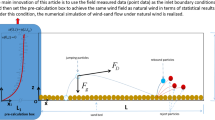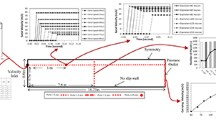Abstract
The Smoothed Particle Hydrodynamics (SPH) method is used to numerically simulate the unsteady sand ripple wind-sand flow movement in a small scale. Compared with the traditional grid-based numerical method, the SPH method uses discrete independent particles to represent the solution domain, get rid of the constraints of the computational grid, and completely solve various problems caused by large deformation or distortion of the grid based on the Euler grid method. Because it also includes the Lagrangian dynamics method, it can easily track the trajectory of any single particle, so the SPH method has unique advantages when dealing with the two-phase flow coupling of wind and sand. This paper expounds the theoretical basis and calculation method of SPH method and focuses on the design idea of applying the core factors in the SPH formula to the numerical simulation program. By discretizing the SPH numerical model of the sand ripple wind-sand two-phase flow, the temporal and spatial changes of the sand particle group on the slope surface during the wind-sand movement are simulated. The formation and development process of macro-wind-sand flow and the saltation law of micro-typical particles are analyzed, which are consistent with the existing wind tunnel experiment results, and the accuracy of SPH numerical simulation method is verified. The results show that the calculation accuracy of this method is high, and it provides a scientific theoretical basis for our further research and prevention of sand damage.
Graphic abstract

















Similar content being viewed by others
References
N. Huang, X.J. Zheng, Mech. Eng. 29, 9–16 (2007)
Y. Shao, Physics and Modelling of Wind Erosion (Springer, New York, 2008)
Y.H. Zhou, X. Guo, X.J. Zheng, Experimental measurement of wind-sand flux and sand transport for naturally mixed sands. Phys. Rev. E 66(2), 021305 (2002)
Z.B. Dong, H.Y. Sun, A.G. Zhao, J. Desert Res. 23, 714–720 (2003)
Zheng X J, Huang N, Zhou Y H. Laboratory measurement of electrification of wind-blown sands and simulation of its effect on sand saltation movement. Journal of Geophysical Research-Atmospheres, 108(D10): Art. No.4322 (2003)
Z.B. Dong, J. Desert Res. 22, 101–105 (2002)
R.A. Bagnold, The Physics of Blown Sand and Desert Dunes (Springer, New York, 1974)
Q.C. Sun, G.Q. Wang, Chin. Sci. Bull. 46, 254–256 (2001)
I.K. McEwan, B.B. Willetts, Numerical Model of the Saltation Cloud (Springer, New York, 1991)
J.J. Wu, L.H. He, X.J. Zheng, J. Lanzhou Univ. 38, 15–21 (2002)
L.Q. Kang, L.J. Guo, J. Eng. Thermophys. 27, 441–444 (2006)
S.Z. Wu, C.Y. Ren, J. Lanzhou Univ. (Nat. Sci.) 48, 104–107 (2012)
S.C. Zhang, Chin. J. Comput. Phys. 13, 2–14 (1996)
L.B. Lucy, Astrophys. J. 8, 1013–1024 (1997)
Benz W. Smooth particle hydrodynamics: a review. In: Numerical modelling of nonlinear stellar pulsation: problems and prospects. Dordrecht: Kluwer Academic Publisher, p. 269–88 (1990)
Liu GR (2002) Mesh-free methods: moving beyond the finite element method. CRC Press, Boca Raton
R.A. Bagnold, Prog. Phys. Geogr. 18, 91–96 (1994)
J.N. Tang, X.Y. Xu, H.X. Jin et al., J. Beijing For. Univ. 29, 111–115 (2007)
Y.Q. Ling, Z. Wu, Acta Geogr. Sin. 35, 174–181 (1980)
T.D. Miao, S.Z. Wu, Q.S. Mu, Computer simulation of the development process of wind sand ripple. Prog. Nat. Sci. 288(1), 16–22 (2001)
X.Y. Zou, Z.L. Wang, Q.Z. Hao et al., Geomorphology 36, 155–165 (2001)
L.Q. Kang, L.J. Guo, D.Y. Liu, Experimental study on velocity distribution of sand particles in aeolian sand flow. Sci. Sin. (2008)
Z.B. Dong, H.T. Wang, X.P. Liu et al., Geomorphology 45, 277–289 (2002)
M.L. Sweet, G. Kocurek, Sedimentology 37, 1023–1038 (1990)
S. Cong, Z.N. Li, B. Gong et al., J. Build. Struct. 40, 205–214 (2019)
B. Huang, Z.N. Li, S. Cong et al., J. Nat. Disasters 25, 9–19 (2016)
Acknowledgements
This work is supported by the National Natural Science Foundation of China (11662019).
Author information
Authors and Affiliations
Contributions
Xiao Hu was involved in the preparation of the manuscript. Xiao Hu and Reyihanguli Musa conceived the presented idea. Afang Jin and Xiao Hu have designed the research. Xiao Hu did the post-processing analysis and wrote the manuscript. All the authors have read and approved the final manuscript.
Corresponding author
Rights and permissions
About this article
Cite this article
Hu, X., Jin, A. & Musa, R. SPH numerical simulation of non-steady sand ripple wind-sand flow structure. Eur. Phys. J. E 45, 11 (2022). https://doi.org/10.1140/epje/s10189-022-00168-4
Received:
Accepted:
Published:
DOI: https://doi.org/10.1140/epje/s10189-022-00168-4




